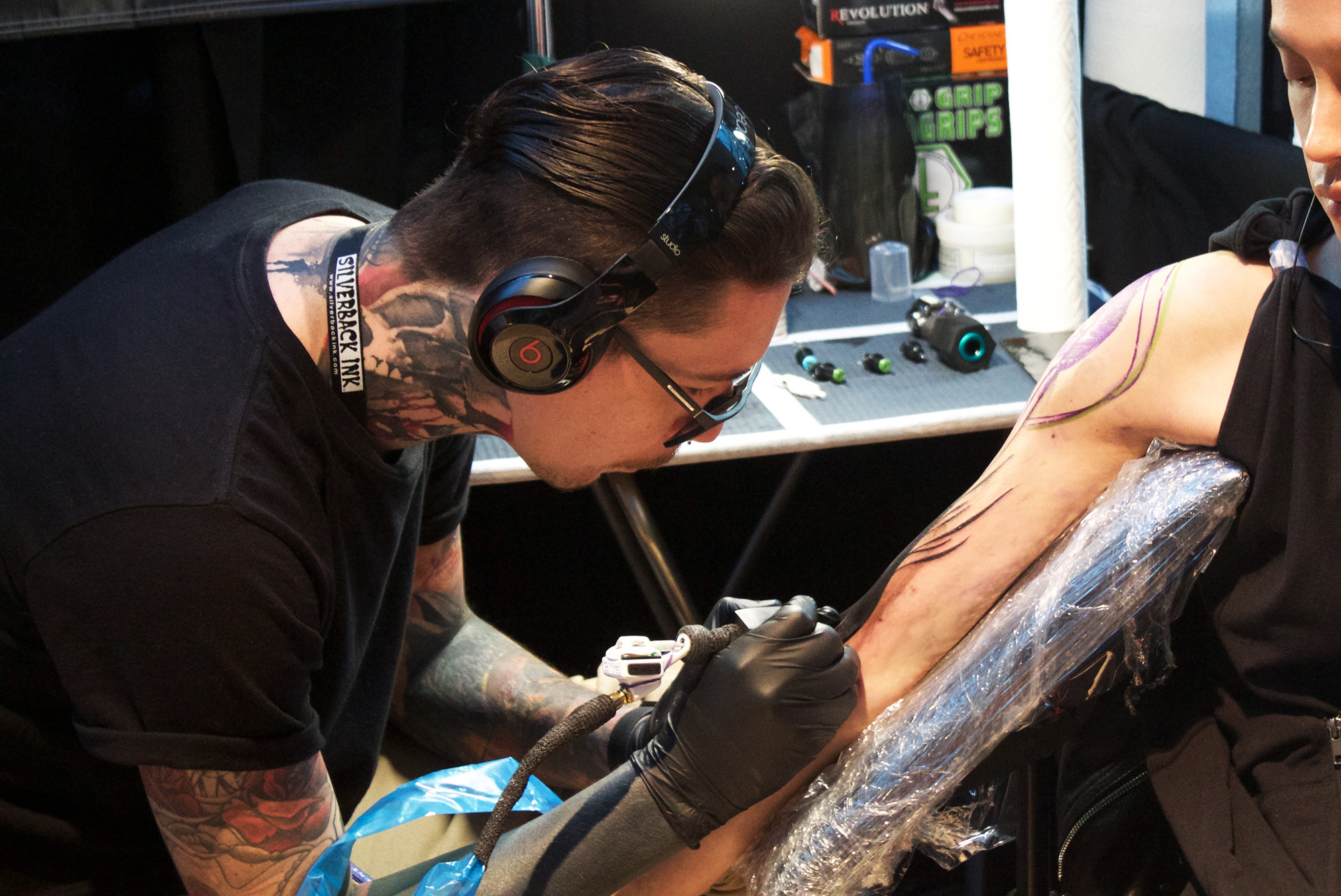
Scene360 has a particular appreciation for the work of Brazilian-born tattoo artist Frank Carrilho, whose stunning “chaotic blackwork” style we’ve featured twice before. You can imagine our excitement when we learned Carrilho was attending the 15th annual Art Tattoo Montreal Show, and we quickly lined up an exclusive interview with him.
Carrilho has become increasingly recognized for his work, and deservedly so; working entirely in black ink, he sketches ethereal animals, twisted religious figures, and other dark creations that flow seamlessly with the human form. He has worked hard to achieve his unique aesthetic, and by challenging the rules in pursuit of artistic freedom, his work continues to evolve.
Carrilho focused his time at Art Tattoo Montreal working on larger-scale tattoos, including the gorgeous pelican half-sleeve documented here. On the Sunday, before he began his last piece, we sat down with him to discuss what it’s like being a traveling tattoo artist, what it means to tattoo with “no rules,” his advice for aspiring artists, and more.
Top: Frank Carrilho working on his Saturday tattoo at Art Tattoo Montreal.
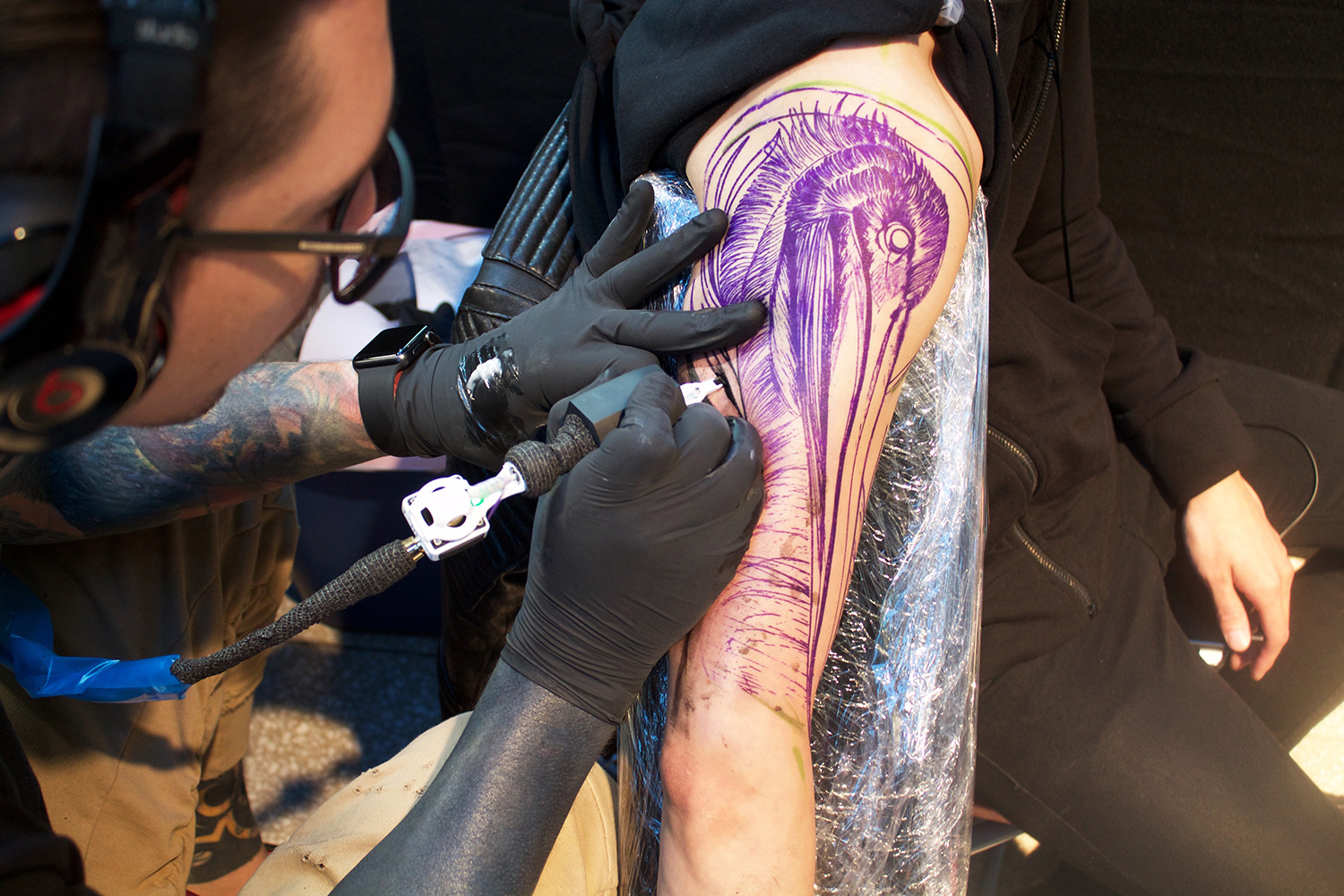
With the stencil ready to go, Carrilho starts inking.
In previous discussions with Scene360, you talked about how you discovered your style, you realized you had “total freedom with [your] lines . . . no rules.” What is it like to tattoo without any rules?
That’s a pretty good question. People laugh sometimes when I say I have no rules, but it’s not totally like that. When you start tattooing, you have some rules—technical rules. For example, you have needles for lining, you have needles for shading, you have needles for packing. So you absorb that, and you start in that way. Like, this needle is for lines, so you have to do lines with that one. This one is for packing, so you can only do packing with that. When I say I have no rules, it’s because of this; I learned that way, but with experience, I decided to change. Why can’t I do a line with needles for color packing? Why can’t I do packing with needles for lines? That’s why I say I have no rules.
And [in regards to] my lines and freedom, I have no rules with this, either. Previously, I would show a design to a client, but I always say that my work is sometimes random, and when I design something, I’ll think about it—the placement, how fluid it’s going to look on the body. I think about [all] this, but when you start tattooing, things change; you have another idea, so why can’t you put it on the skin? When my clients book something with me, I feel really glad, because they already know about [my style], so they come in pretty open. I show the [design] and I start, following the stencil, but in the process another idea comes, so I add [to it].
So that’s why I say I have no rules, because I have so much freedom, and I have no rules with needles, too. [This way,] I can put different effects in my tattoo—it’s more like sketching. [. . .] And people have different ways of sketching. When you’re learning how to draw, you have some rules. But over time you change—you find your own way to do it. And this doesn’t mean it’s better or less better than the original process. But that’s why I say I have no rules: because I find my own way, and I do my own way.
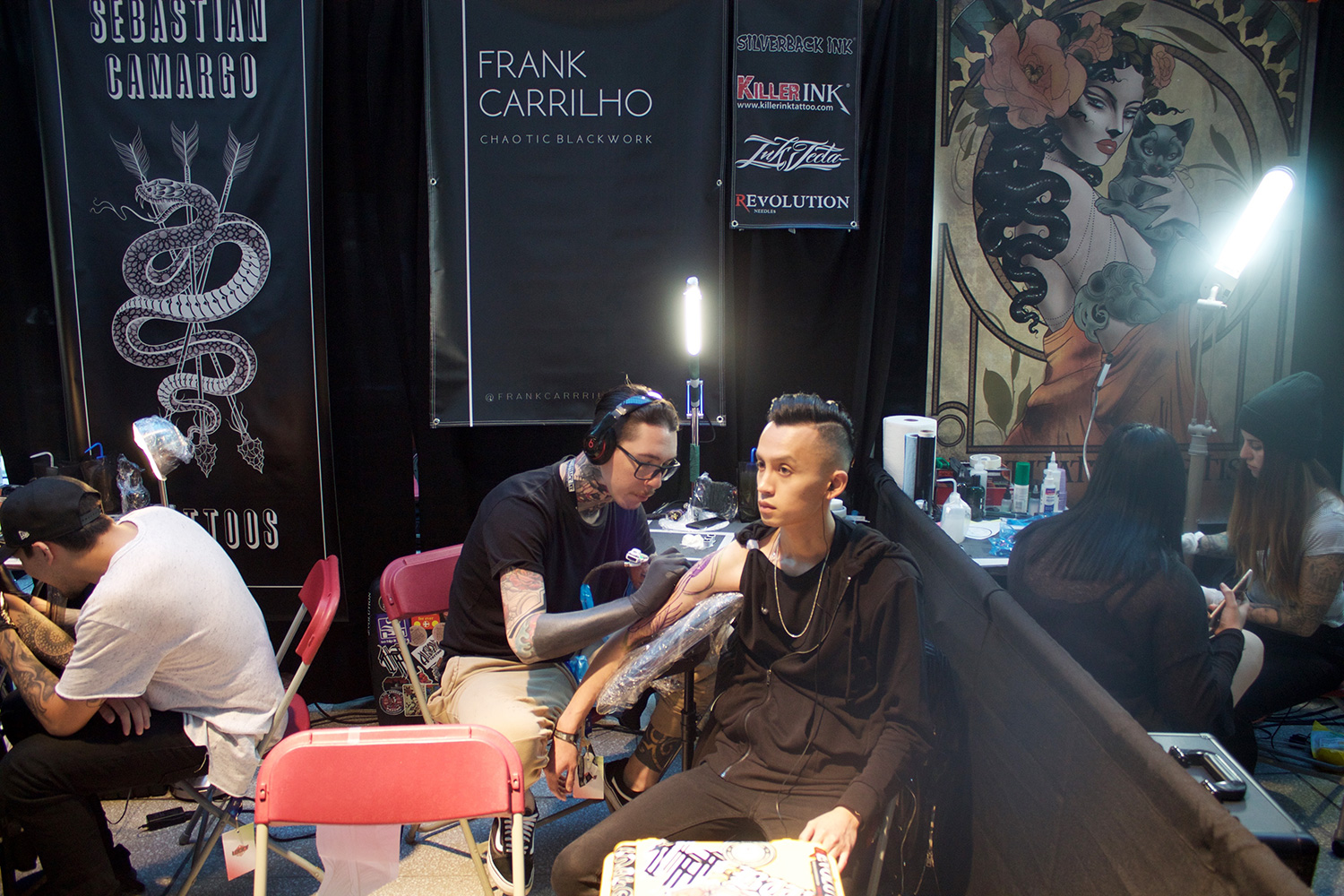
Carrilho’s booth at Art Tattoo Montreal.
Because of your organic, chaotic style, how does this affect your relationships with your clients? I imagine a lot of trust and communication must occur.
In the beginning, it was really, really hard. I think every tattoo artist has this problem, because working with people is hard. You have your opinion, and the [client] has a different opinion from you. But when I started to get recognized for something I did, for my style, basically people started to ask me for pieces, and they came [to me] pretty open. They had read something about my work, so they already came prepared. So basically, [my clients are] like customers: they really want something by me. This brings me more freedom, so I’m really happy about this.
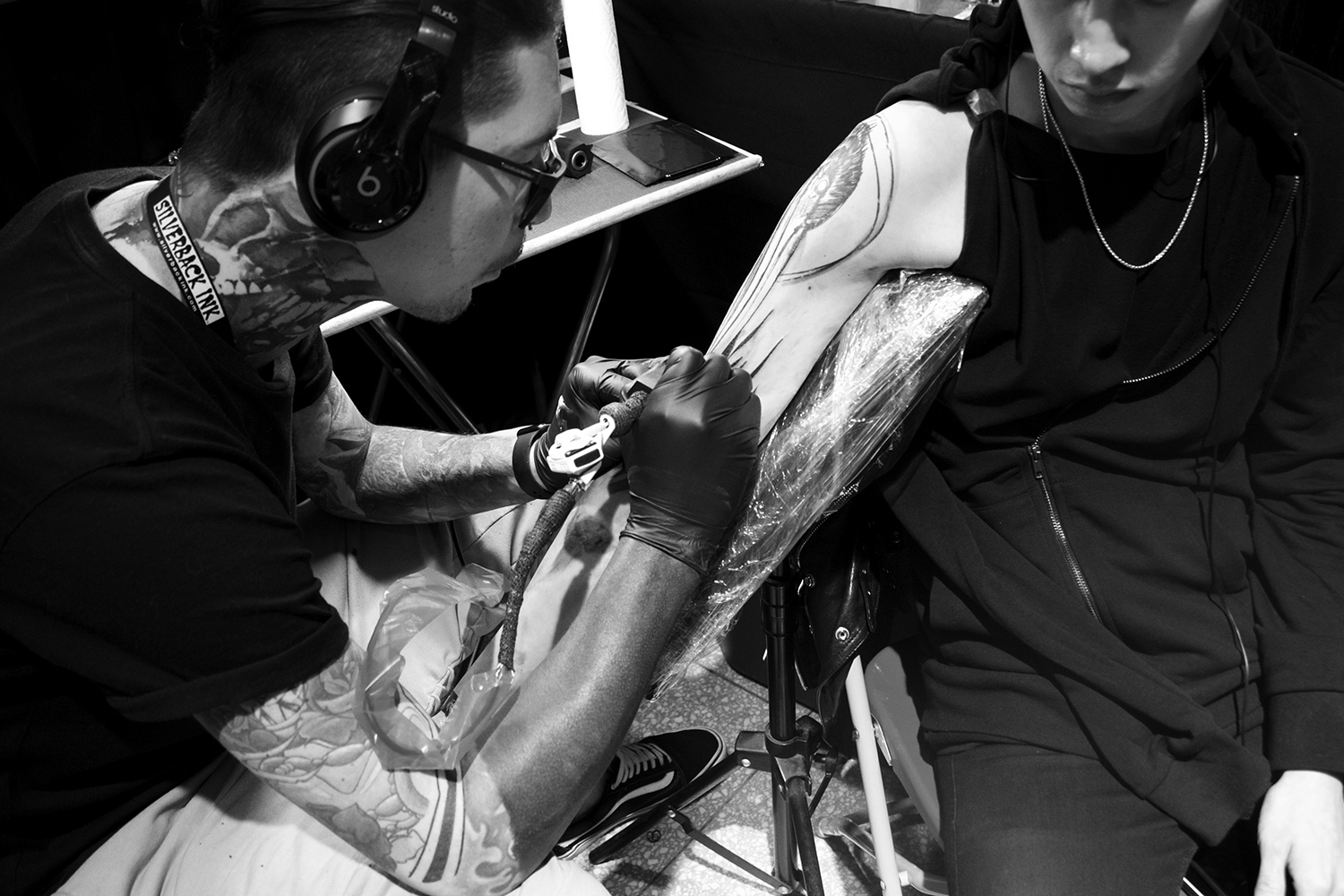
This tattoo took a total of six hours to complete.
From my knowledge of tattoos, most artists start with the outline and go from there. Because your tattoos more closely resemble sketches, what are your stages to creating a tattoo? Do you have stages?
I started to pay attention to this, [because] people started asking me about the process, and about the needles. I think I follow the process of realist tattoos. Maybe it’s because the latest style I’ve tried is realism—like I did a realist black-and-grey style for one and half to two years, and I really like realist tattoos. I [tattoo] step by step. I don’t line everything, because I think if I line everything, I close my ideas.
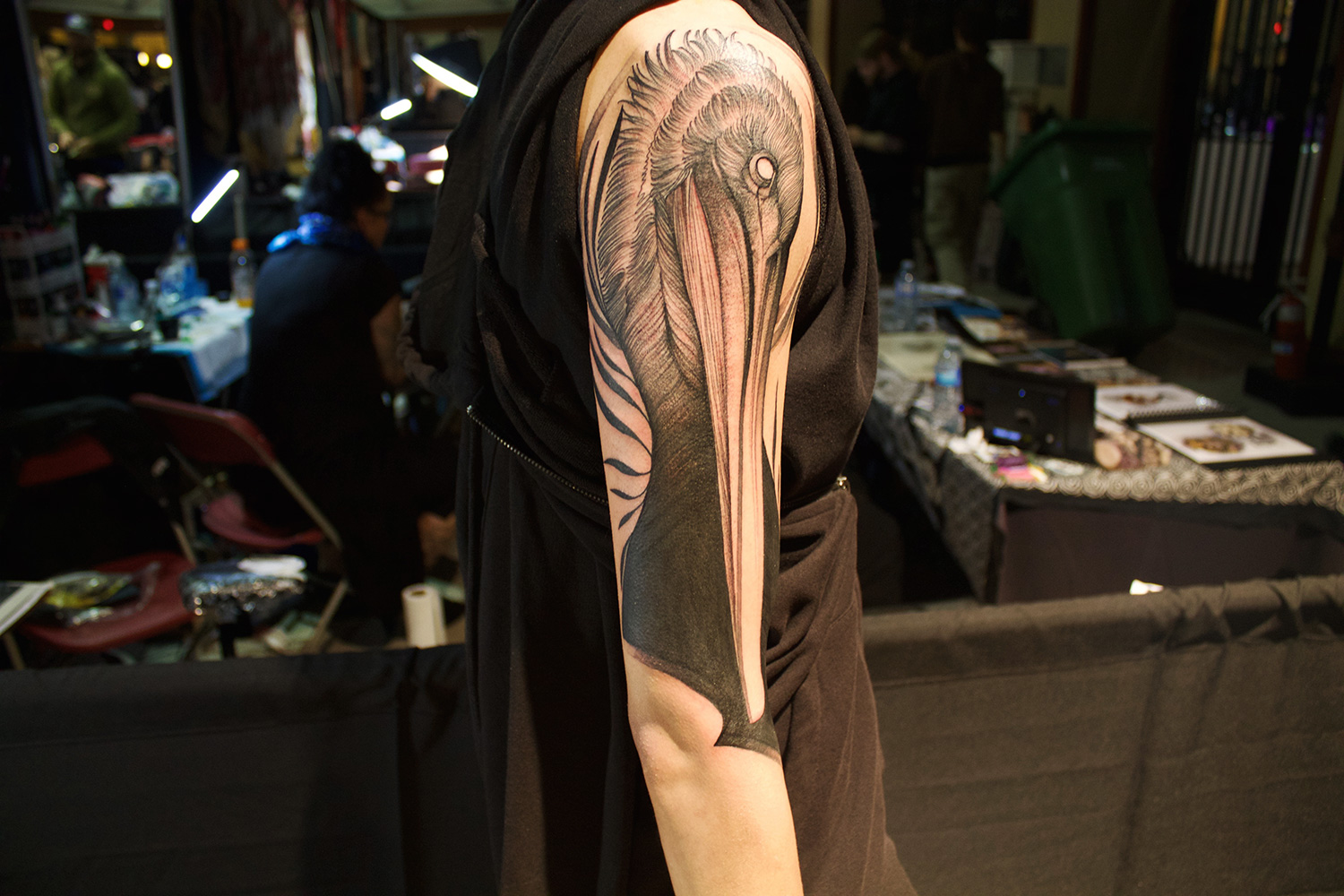
The finished piece: a dynamic, spectral pelican that fits the client’s arm perfectly.
What are your favorite subjects to tattoo?
I love animals. I like a mix of creepy things, too. I work with a lot of black. I think black ink always brings . . . something dark. Negative eyes, with the black and shadow: this brings out something creepy, and I like it. I like to do skulls . . . I think every tattoo artist loves to do skulls. I really like it, but I like to mix [things up]. I like creepy things—like religious [imagery], because I’m not that religious. So I like when people complain about that—like, “Holy shit, that guy did a Jesus Christ with a cross upside down,” you know? It’s crazy, I like it.
You are a big advocate for Silverblack Ink. In your experience, what makes this ink special?
Silverblack is so f***ing black. And that’s what I like in my work—I put in a lot of black. And it’s vegan, so it’s good for the body.
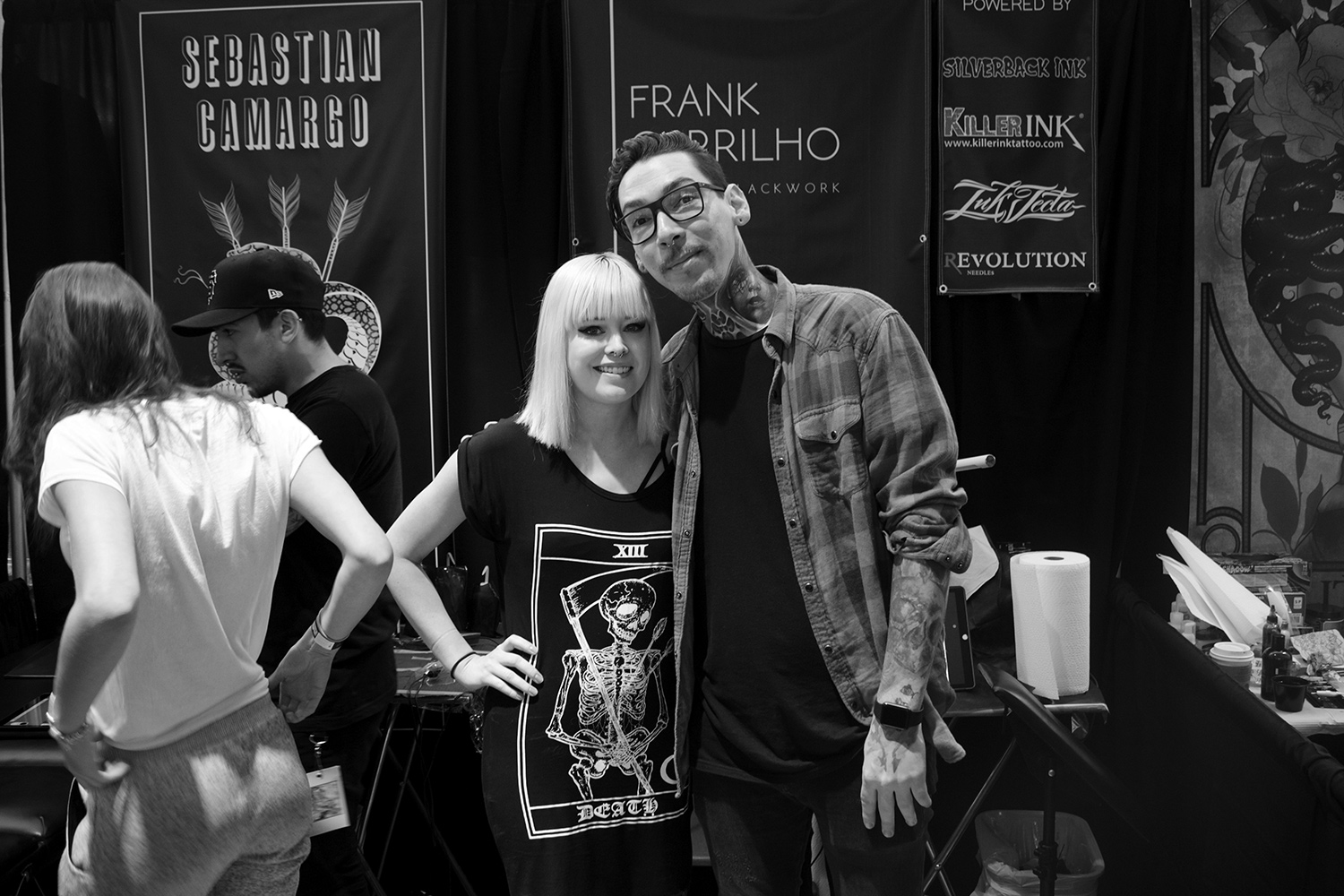
A photo taken after our interview, with Carrilho (right) and Scene360’s Hayley Evans (left).
You’ve responded to people who think tattoo artists have glamorous lifestyles, showing yourself working until 11:00 at night. Can you tell us about the sacrifices and struggles that tattoo artists actually face, working in the industry?
I think in the tattoo [world], we have these glamorous tattoo artists . . . like [tattoo] Beyoncés. And I don’t like it at all. People say, “Oh, you’re starting to get famous, you’re like a Justin Bieber of tattoos.” People come to talk with me just to say hi and “I love your work.” And I try not to get contaminated by this, because this is real life, and I think you [can] lose perception.
Today is really, really good for me—everything about my work is really, really good—but I try to keep my feet on the ground, because I don’t know about tomorrow . . . Like some day, if the tattoo business is not that good and I have to go back and do infinity tattoos and script tattoos, I’ll do it, because I love tattooing. For some artists who live this glamorous life, I think if something happens with them, they’re going to freak out—so that’s why I keep my feet on the floor.
And so, about working late: I think when you love something, you work on it. It doesn’t matter what it is. And I love what I do. And obviously I always strive to do my best for my clients, and do my best for me, too, because I like to see what I did after. And sometimes I feel proud of myself—I like that feeling. And because of this I always try to do my best. And I think the best way you do your best is to push your level. And to push your level, you have to work hard. And I work hard, I try to work hard, and I think that’s the key. Some people think it’s easy, but they don’t know where you’re coming from. I’ve been tattooing for 10 years already, I started in 2007. And some people really, really know my journey, and they know it’s not so easy. I live in the moment right now; people are talking about my work, and that’s really nice, but I try and not get comfy about this, or lazy, or an attitude. So I’m just going to live the dream.
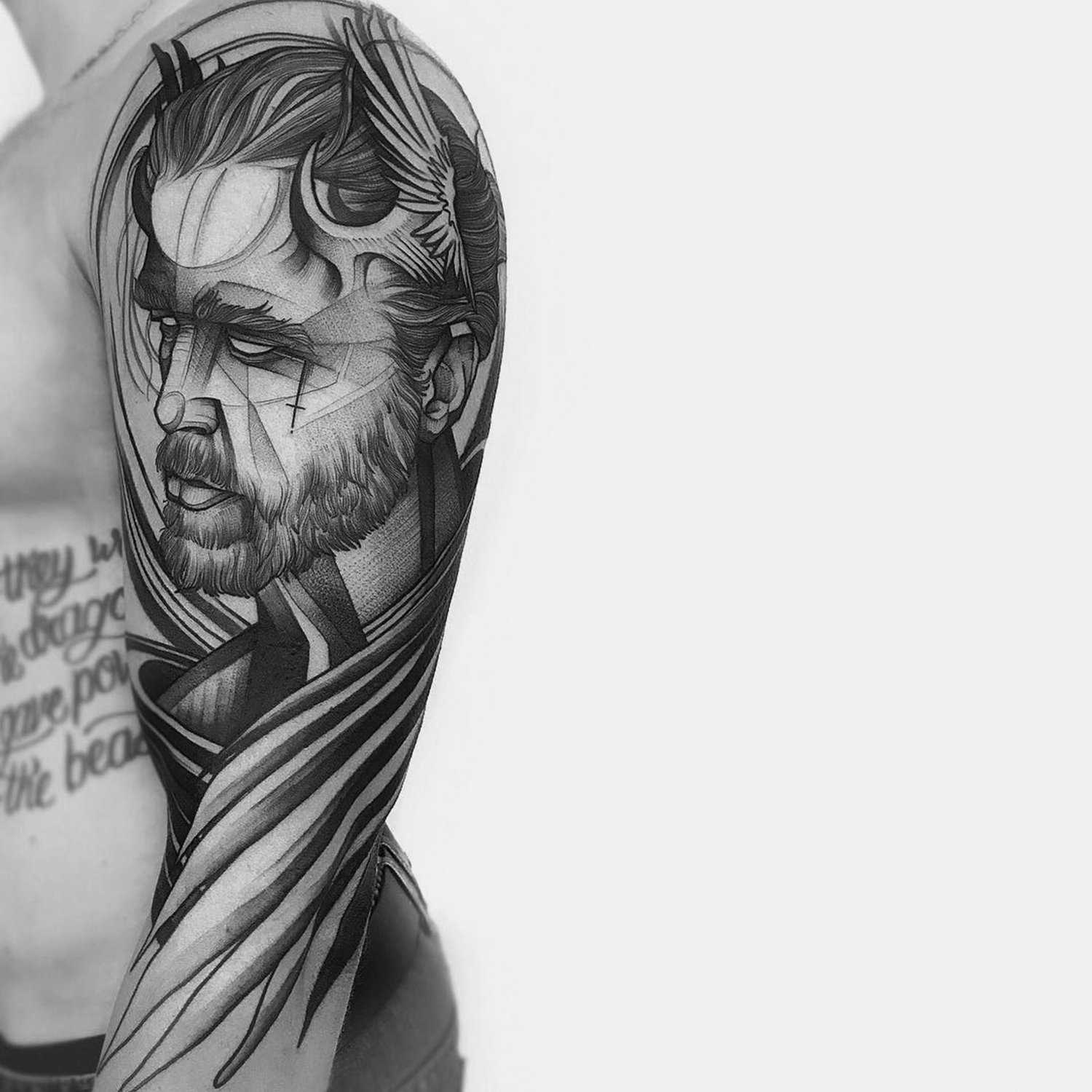
Another example of Carrilho’s work, featuring his love of dark and quasi-religious imagery.
What would be your main advice for a passionate young artist starting off on his or her tattoo journey?
Do everything. If you love tattooing, do everything [in regards to] tattooing. I say this because I already have some experience. Some people say, “Oh, I want to be a tattoo artist,” “Oh, I want to do realist tattoos,” “Oh, I want to do black work, because everybody’s talking about black work, and you can do black work and get famous like that [snaps fingers].” And I say, “Okay, I think for some people it can work, but in general, I think the best way is [just doing] tattoos. It doesn’t matter if it’s script, or realist, or nice pieces, or something you don’t like that much; just tattoo it, because one day, if you do something different than everybody, you can use everything you learned—like Japanese style, realist tattoos, tribal and traditional tattoos—and you can put it in your work to do something different. So I think the key is just tattooing. Try, and try, and try—and that’s it.
Tattoo art © Frank Carrilho. Updated Interview 2019. Photos by Hayley Evans, © Scene360
